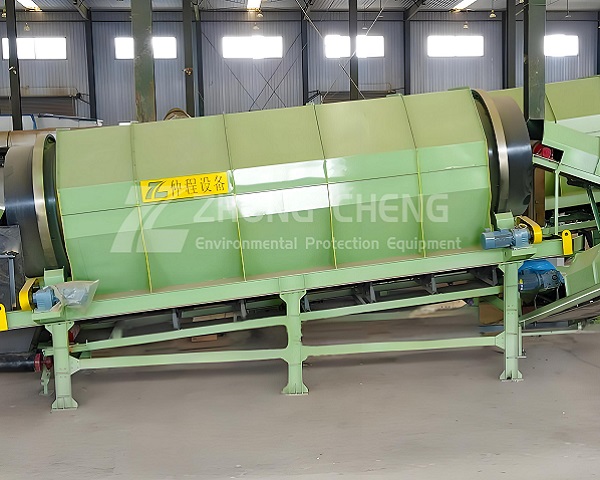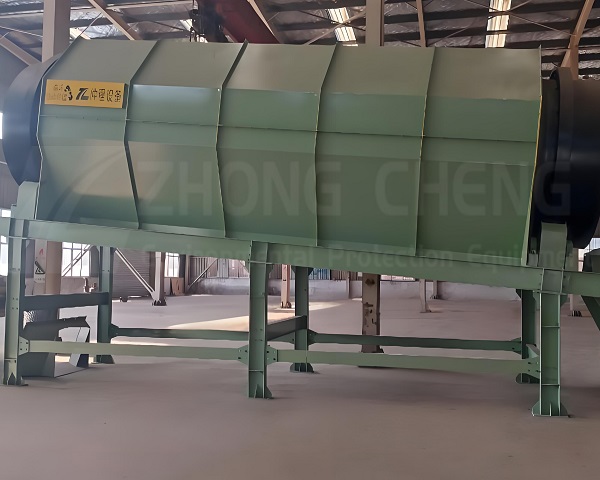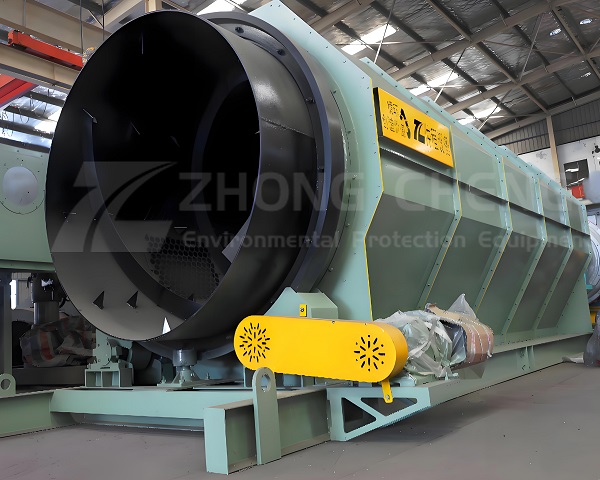As a key piece of equipment for material classification in industries such as mining, building materials, and environmental protection, the screening effect of rotary trommel screens directly affects subsequent production efficiency and product quality. In actual operation, problems such as screen clogging, uneven material distribution, and improper parameter adaptation can easily lead to low screening efficiency and poor particle size accuracy. To address these pain points, this article systematically sorts out key strategies for improving screening effect from four core dimensions: equipment parameter optimization, material pretreatment, operating procedures, and daily maintenance, combined with specific process data and practical solutions. This provides a scientific reference for enterprises to optimize production processes, reduce operating costs, and help achieve efficient and accurate screening.
A. Optimizing Core Equipment Parameters to Adapt to Material Characteristics

1. Precisely Matching Screen Parameters
The screen is the core component of screening, and its parameter selection directly determines screening accuracy and efficiency. First, it is necessary to select an appropriate screen aperture size according to the material particle size requirements. Generally, the screen aperture diameter should be 1.2-1.5 times the target separation particle size. For example, when separating 5mm particle size materials, a 6-7.5mm screen aperture is recommended to ensure throughput while avoiding excessive clogging. Secondly, the screen material must be suitable for the material characteristics: when processing abrasive materials (such as granite and iron ore), high-manganese steel or polyurethane screens are recommended, as they improve wear resistance by more than 30%; when processing sticky materials (such as wet clay), polyurethane screens are preferred, as their smooth surface reduces material adhesion. Simultaneously, the screen opening ratio should be controlled between 40% and 60%. Too low an opening ratio will reduce screening efficiency, while too high an opening ratio will affect screen strength. The opening ratio can be increased by using diamond or rectangular screen holes, with rectangular screen holes (length-to-diameter ratio 2:1) being more suitable for processing flaky materials.
2. Adjusting the trommel speed and inclination angle: The trommel speed needs to be dynamically adjusted according to the particle size and density of the material. Too high a speed can lead to excessive centrifugal force on the material, preventing sufficient contact with the screen; too low a speed results in insufficient residence time of the material within the screen, leading to incomplete screening. Generally, the trommel rotation speed should be controlled between 15-30 r/min. For fine granular materials (particle size < 3 mm), the rotation speed can be appropriately increased (25-30 r/min) to enhance the material agitation frequency; for coarse granular materials (particle size > 10 mm), the rotation speed should be reduced (15-20 r/min) to extend the residence time. The trommel inclination angle is also crucial. An excessively large inclination angle results in a rapid material descent and a short residence time; an excessively small inclination angle easily leads to material accumulation. The ideal inclination angle is 3°-8°. For materials with good flowability, the upper limit (6°-8°) should be used, while for viscous or wet materials, the lower limit (3°-5°) should be used. The inclination angle can be precisely calibrated by adjusting the support bolts at the bottom of the frame.
3. Optimize the in-screen guiding and cleaning device. Adding guide plates inside the trommel can guide the material to distribute evenly and avoid localized accumulation. The guide plates should be spirally arranged along the inner wall of the trommel, with a height of 1/10-1/8 of the trommel diameter and a spacing of 500-800mm. This ensures that the material forms a uniform layer inside the screen, with the layer thickness controlled at 2-3 times the diameter of the screen openings. Excessive thickness will prevent the lower layer of material from contacting the screen. Simultaneously, a high-efficiency cleaning device is required: when processing dry materials, install a brush or rubber scraper cleaner, closely attached to the inner side of the screen, rotating synchronously with the trommel to promptly remove blockages in the screen openings; when processing sticky materials, use a high-pressure spray device, with the water pressure controlled at 0.3-0.5MPa, and the spray direction opposite to the material movement direction, cleaning the screen and reducing the material's stickiness. Furthermore, some equipment can be equipped with an ultrasonic screen cleaning device, which uses high-frequency vibration (20-40kHz) to prevent fine particles from clogging the screen openings, improving cleaning efficiency by over 40%.
B. Enhance Material Pretreatment to Reduce Screening Difficulty

1. Control Material Moisture and Particle Size
Material moisture is a key factor affecting screening efficiency. When the moisture content exceeds 8%, fine particles easily clump together, clogging the screen holes. For wet materials, pre-drying is necessary. The drying temperature should be controlled between 60-120℃ according to the material characteristics to ensure the moisture content is reduced to below 5%. If drying is not possible, desiccants (such as quicklime or bentonite) can be added, or a grading screening process can be used to first remove large particles and then process the fine particles separately. Simultaneously, the feed particle size must be controlled. The maximum feed particle size should not exceed three times the screen hole diameter; otherwise, it will cause screen overload and damage, and large pieces of material are prone to jamming the screen, affecting screening continuity. A grid or pre-crusher can be installed at the feed inlet to remove oversized materials in advance, ensuring uniform feeding.
2. Optimize Feeding Method and Uniformity Uneven feeding leads to unbalanced material distribution within the screen, causing localized overload and localized idling, reducing screening efficiency. A hopper + feeder feeding mode should be adopted, using a vibrating feeder or screw feeder. The feed rate should be controlled by adjusting the feeding speed to ensure that the feed rate per unit time matches the trommel screen's processing capacity (usually 80%-90% of the equipment's rated capacity). A material distribution device, such as a flow divider or distributor, should be installed at the feed inlet to ensure even material distribution along the trommel axis, avoiding bias to one side. Furthermore, sudden large-scale feeding should be avoided. A level sensor can be installed at the bottom of the hopper to monitor the material level in real time, and stable feeding can be achieved by automatically adjusting the feeder frequency.
C. Standardize Operating Procedures to Improve Operational Stability

1. Strictly Follow Start-up and Shutdown Procedures A comprehensive inspection must be performed before starting: confirm that the screen is undamaged, the cleaning device is securely installed, the trommel rotates flexibly, and all lubrication points (bearings, gearbox) have sufficient lubricating oil. When starting the machine, follow the sequence of "no-load start-up → gradual feeding → stable operation." Run the machine under no-load for 5-10 minutes to check if the trommel speed, vibration, and noise are normal. If no abnormalities are found, slowly increase the feed rate to avoid sudden overload and equipment failure. Before stopping the machine, stop feeding and continue running under no-load for 3-5 minutes to clear any residual material from the screen and prevent material from clogging the screen during the next startup.
2. Real-time monitoring and dynamic adjustment: During operation, a dedicated person should conduct inspections, judging the screening effect through "seeing, listening, and measuring": Observe whether the product particle size at the discharge port is uniform and whether there are large pieces of material mixed in; listen to the operating noise of the equipment; if a sharp abnormal noise occurs, it may be due to screen damage or a loose cleaning device; measure the screening efficiency by weighing (qualified product mass / total feed mass × 100%). If the efficiency is lower than 85%, the parameters need to be adjusted promptly. When the characteristics of the processed material change (such as changes in moisture content or particle size distribution), the trommel speed, inclination angle, or feed rate needs to be dynamically adjusted. For example, when the material moisture content increases, the feed rate can be reduced, the speed increased, and the spray cleaning device activated.
D. Strengthen daily maintenance to extend equipment life and screening accuracy

1. Regularly inspect and replace screens. Long-term use of screens will result in wear, deformation, or damage. A regular inspection system needs to be established: Before starting the machine each day, check the screen surface for holes and whether the edges are loose. Measure the screen aperture size weekly. When the screen aperture wear exceeds 20% of its original size or is damaged, replace the screen promptly. When replacing the screen, ensure it is securely installed, and seal the connection between the screen and the trommel flange with sealant to prevent material leakage from gaps, which would affect screening accuracy. In addition, keep spare screens of different aperture sizes for quick switching according to production needs, improving equipment adaptability.
2. Proper Lubrication and Maintenance: The bearings, gearbox, and other transmission components of the trommel screen require regular lubrication. Bearings should be lubricated with lithium-based grease (model L-AN46) every 500 hours of operation and completely replaced every 2000 hours. The gearbox should be filled with industrial gear oil (model N320) and replaced every 3000 hours, cleaning the oil tank before replacement. Additionally, after each day's operation, clean the equipment surface and the inside of the trommel to remove any residual material, paying particular attention to the cleaning device to prevent material adhesion and maintain cleaning effectiveness. The spray system should be cleared weekly to prevent nozzle blockage and ensure stable water pressure.
3. Timely Handling of Equipment Faults
Common Faults and Troubleshooting:
1. Low screening efficiency may be due to clogged screen holes, excessive rotation speed, or excessive tilt angle. Clean the screen, adjust the rotation speed, or reduce the tilt angle.
2. Uneven product particle size is often caused by uneven feeding or screen breakage. Optimize the feeding method or replace the screen.
3. Excessive equipment vibration may be due to unbalanced trommels, damaged bearings, or loose anchor bolts. Perform a dynamic balancing test on the trommels, replace bearings, or tighten bolts.
4. Frequent screen breakage is often caused by excessive feed particle size or the presence of hard objects in the material. Strengthen feed pretreatment and remove large hard objects.
Improving the screening effect of trommel screens requires building a comprehensive optimization system encompassing "equipment - material - operation - maintenance." By accurately matching screen parameters, dynamically adjusting trommel speed and tilt angle, strengthening material pretreatment, and standardizing operating procedures, core issues such as screen clogging and uneven particle size can be effectively resolved. In routine maintenance, regularly inspecting and replacing screens, lubricating transmission components, and troubleshooting can extend equipment life and maintain screening accuracy. These strategies work together to increase screening efficiency to over 85% while reducing energy consumption and losses. They are suitable for screening different materials in various industries, providing a strong guarantee for enterprises to achieve efficient and stable production.
Save Time! Get A Detailed Quotation Quickly.
